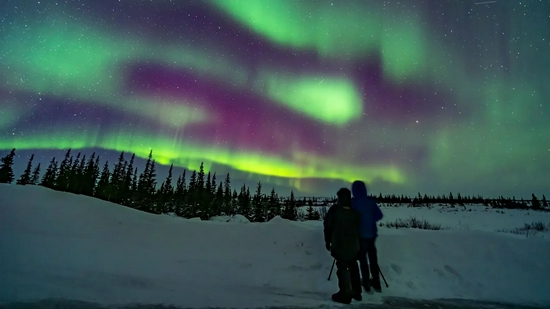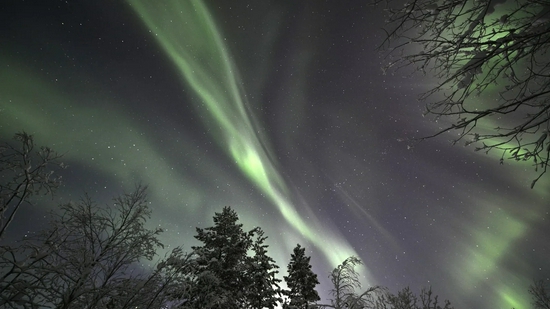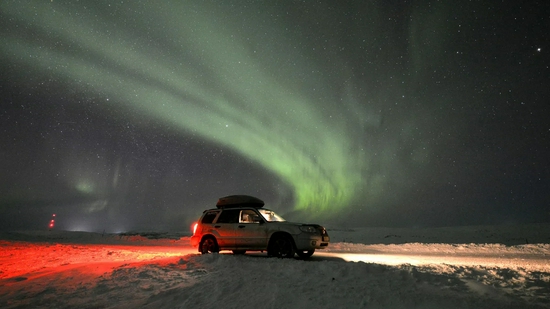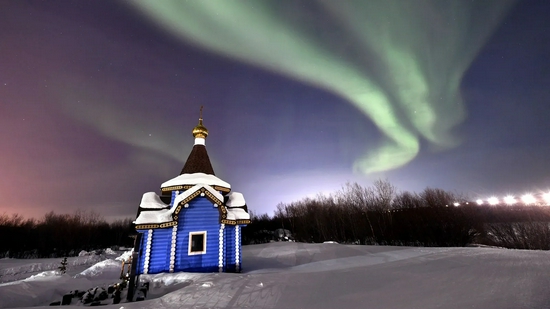有一种神秘现象困扰了观测者几个世纪:有着奇妙颜色的北极光会产生任何可识别的声音吗?由于太阳粒子和地球大气中气体分子发生相互作用,极光通常发生在地球两极附近,那里的磁场最强。然而,关于极光发出声音的报道非常罕见,而且一直以来都被科学家们忽视。

The people who claim to hear the Northern Lights
It's a question that has puzzled observers for centuries: do the fantastic green and crimson light displays of the aurora borealis produce any discernible sound?
这是一个困扰了观测者几个世纪的问题:有着奇妙颜色的北极光会产生可辨别的声音吗?
Conjured by the interaction of solar particles with gas molecules in Earth's atmosphere, the aurora generally occurs near Earth's poles, where the magnetic field is strongest. Reports of the aurora making a noise, however, are rare – and were historically dismissed by scientists.
由于太阳粒子与地球大气中的气体分子相互作用,极光通常发生在地球的两极附近,那里磁场最强。但关于极光发出声音的报道非常罕见,而且一直以来都被科学家们所忽视。
But a Finnish study from 2016 claimed to have finally confirmed that the Northern Lights really do produce sound audible to the human ear. One of the researchers involved in the study captured a sound, possibly made by the captivating lights, that was estimated to have originated 70m (230ft) above ground level.
但2016年芬兰的一项研究最终证实,北极光确实能发出人耳能听到的声音。参与这项研究的一名研究人员捕捉到一种声音,据估计是由这些迷人的光所发出的,声音来自于地面以上70米(230英尺)的地方。
Still, the mechanism behind the sound remains somewhat mysterious, as are the conditions that must be met for the sound to be heard. My recent research takes a look over historic reports of auroral sound to understand the methods of investigating this elusive phenomenon and the process of establishing whether reported sounds were objective, illusory or imaginary.
不过,这种声音背后的机制仍有些神秘,就像要听到这种声音必须满足的条件一样。我最近的研究回顾了关于极光声音的报道,以了解如何研究这一难以捉摸的现象,以及确定所报道的声音是客观、虚幻还是虚构的。
Auroral noise was the subject of particularly lively debate in the first decades of the 20th Century, when accounts from settlements across northern latitudes reported that sound sometimes accompanied the mesmerising light displays in their skies.
在20世纪头几十年里,极光发出声音是一个特别活跃的争论点。当时来自北纬地区定居点的报告称,声音有时伴随着天空中迷人的光出现。

Witnesses told of a quiet, almost imperceptible crackling, whooshing or whizzing noise during particularly violent Northern Lights displays. In the early 1930s, for instance, personal testimonies started flooding into The Shetland News, the weekly newspaper of the subarctic Shetland Islands, likening the sound of the Northern Lights to "rustling silk" or "two planks meeting flat ways".
目击者称,在特别猛烈的北极光出现期间,会有一种轻微的、几乎察觉不到的爆裂声或嗖嗖声。例如在20世纪30年代早期,在亚北极设得兰群岛(Shetland Islands)的周报《设得兰新闻报》(The Shetland News)上开始出现大量个人证实,将北极光的声音比作“丝绸发出的沙沙声”或“把两块木板拍在一起”。
These tales were corroborated by similar testimony from northern Canada and Norway. Yet the scientific community was less than convinced, especially considering very few western explorers claimed to have heard the elusive noises themselves.
加拿大北部和挪威也有类似证言证实了这些说法。但科学界对此并不信服,尤其是考虑到很少有西方探险家声称自己听到过这种难以捉摸的声音。
The credibility of auroral noise reports from this time was intimately tied to altitude measurements of the Northern Lights. It was considered that only those displays that descended low into the Earth’s atmosphere would be able to transmit sound which could be heard by the human ear.
这个时期极光声音报告的可信度与北极光的海拔测量密切相关。人们认为,只有那些下降到地球大气层较低的极光才能传出人耳能听到的声音。
The problem here was that results recorded during the Second International Polar Year of 1932-33 found aurorae most commonly took place 100km (62 miles) above Earth, and very rarely below 80km (50 miles). This suggested it would be impossible for discernible sound from the lights to be transmitted to the Earth's surface.
问题是1932至1933年第二个国际极地年(Second Intenational Polar Year)的记录显示,极光最常发生在地球上空100公里(62英里)的地方,而在80公里(50英里)以下的地方很少见。这表明光发出的可辨识的声音不可能传输到地球表面。

Given these findings, eminent physicists and meteorologists remained sceptical, dismissing accounts of auroral sound and very low aurorae as folkloric stories or auditory illusions.
鉴于这些发现,著名的物理学家和气象学家仍然持怀疑态度,认为极光发出声音是民间传说或听觉错觉。
Sir Oliver Lodge, the British physicist involved in the development of radio technology, commented that auroral sound might be a psychological phenomenon due to the vividness of the aurora's appearance – just as meteors sometimes conjure a whooshing sound in the brain. Similarly, the meteorologist George Clark Simpson argued that the appearance of low aurorae was likely an optical illusion caused by the interference of low clouds.
参与无线电技术发展的英国物理学家奥利弗·洛奇爵士(Sir Oliver Lodge)说,极光非常生动,可能导致出现一种心理现象,就像流星有时会在大脑中发出嗖嗖声一样。同样,气象学家乔治·克拉克·辛普森(George Clark Simpson)认为,低空极光很可能是由低空云层的干扰造成的一种光学错觉。
Nevertheless, 20th-Century accounts written by two astronomer's assistants claimed to have heard the aurora, adding some legitimacy to the large volume of personal reports.
不过,20世纪两位天文学家的助手所写的报告声称听到了极光,为大量个人报告增加了一些合法性。
One wrote they had heard a "very curious faint whistling sound, distinctly undulatory, which seemed to follow exactly the vibrations of the aurora", while another experienced a sound like "burning grass or spray". As convincing as these two last testimonies may have been, they still didn't propose a mechanism by which auroral sound could operate.
其中一人写道,他们听到了“一种非常奇怪的微弱的哨声,有明显的波动,似乎与极光的振动完全一致”,而另一人则听到了“燃烧的草或喷雾”的声音。尽管最后两个证据很有说服力,但他们没有提出极光声音如何运作的机制。
The answer to this enduring mystery which has subsequently garnered the most support was first tentatively suggested in 1923 by Clarence Chant, a well-known Canadian astronomer. He argued that the motion of the Northern Lights alters Earth's magnetic field, inducing changes in the electrification of the atmosphere, even at a significant distance.
1923年,加拿大著名天文学家克拉伦斯·钱特(Clarence Chant)首次试探性地提出这个经久不衰之谜的答案,后来得到了最多支持。他认为,北极光的运动改变了地球的磁场,导致大气电气化,即便是在相当远的距离。

This electrification produces a crackling sound much closer to Earth's surface when it meets objects on the ground, much like the sound of static. This could take place on the observer's clothes or spectacles, or possibly in surrounding objects including fir trees or the cladding of buildings.
当电气化过程遇到地面物体时,会在离地表更近的地方产生劈啪声,很像静电的声音。这可能发生在观察者的衣服或眼镜上,也可能发生在周围的物体上,包括冷杉树或建筑物的包层。
Chant's theory correlates well with many accounts of auroral sound, and is also supported by occasional reports of the smell of ozone – which reportedly carries a metallic odour similar to an electrical spark – during Northern Lights displays.
钱特的理论与许多关于极光声音的报道很好地联系在一起,也被偶尔报道的臭氧气味所支持——据报道,在北极光显示时,臭氧带有类似电火花的金属气味。
Yet Chant's paper went largely unnoticed in the 1920s, only receiving recognition in the 1970s when two auroral physicists revisited the historical evidence. Chant's theory is largely accepted by scientists today, although there's still debate as to how exactly the mechanism for producing the sound operates.
不过,钱特的论文在20世纪20年代基本上没有引起人们的注意,直到20世纪70年代,两位极光物理学家重新审视了历史证据,才得到认可。钱特的理论在很大程度上被今天的科学家所接受,不过对于产生声音的机制究竟如何运作仍然存在争议。
What is clear is that the aurora does, on rare occasions, make sounds audible to the human ear. The eerie reports of crackling, whizzing and buzzing noises accompanying the lights describe an objective audible experience – not something illusory or imagined.
可以确定的是,极光确实在极少数情况下能让人耳听到声音。许多人对噼啪声、嗖嗖声和嗡嗡声的描述,代表一种客观的听觉体验,而不是幻觉或想象。
If you want to hear the Northern Lights for yourself, you may have to spend a considerable amount of time in the polar regions, considering the aural phenomenon only presents itself in 5% of violent auroral displays. It's also most commonly heard on the top of mountains, surrounded by only a few buildings – so it's not an especially accessible experience.
如果你想亲自听到北极光,可能得在极地花很长时间,因为这种听觉现象只出现在5%的强烈极光中。它也最常在山顶听到,周围只有几栋建筑,所以不是特别容易实现的体验。
In recent years, the sound of the aurora has nonetheless been explored for its aesthetic value, inspiring musical compositions and laying the foundation for novel ways of interacting with its electromagnetic signals.
近年来人们一直在探索极光的美学价值,激发音乐创作,并为了与极光电磁信号相互作用找到新方式奠定了基础。
The Latvian composer Ēriks Ešenvalds has used journal extracts from the American explorer Charles Hall and the Norwegian statesman Fridjtof Nansen, both of whom claimed to have heard the Northern Lights, in his music. His composition, Northern Lights, interweaves these reports with the only known Latvian folk song recounting the auroral sound phenomenon, sung by a tenor solo.
拉脱维亚作曲家Ēriks Ešenvalds在音乐中使用了美国探险家查尔斯·霍尔(Charles Hall)和挪威政治家弗里德托夫·南森(Fridjtof Nansen)的日记节选,两人都声称听到了北极光。他的作品《北极光》(Northern Lights)将这些报告与唯一已知的拉脱维亚民歌交织在一起,这首民歌讲述了极光现象,由男高音独唱。
Or you can also listen to the radio signals of the Northern Lights at home. In 2020, a BBC Radio 3 programme remapped very low frequency radio recordings of the aurora onto the audible spectrum. Although not the same as perceiving audible noises produced by the Northern Lights in person on a snowy mountaintop, these sounds give an awesome sense of the aurora's transitory, fleeting and dynamic nature.
或者你也可以在家收听北极光的无线电信号。2020年,英国广播公司第三电台的一档节目将极光的极低频无线电录制下来,重新映射到可听频谱上。虽然这与在雪山顶上亲耳聆听北极光发出的声音不同,但这些声音仍能给人一种令人敬畏的感觉,让人感悟极光的瞬息万变。